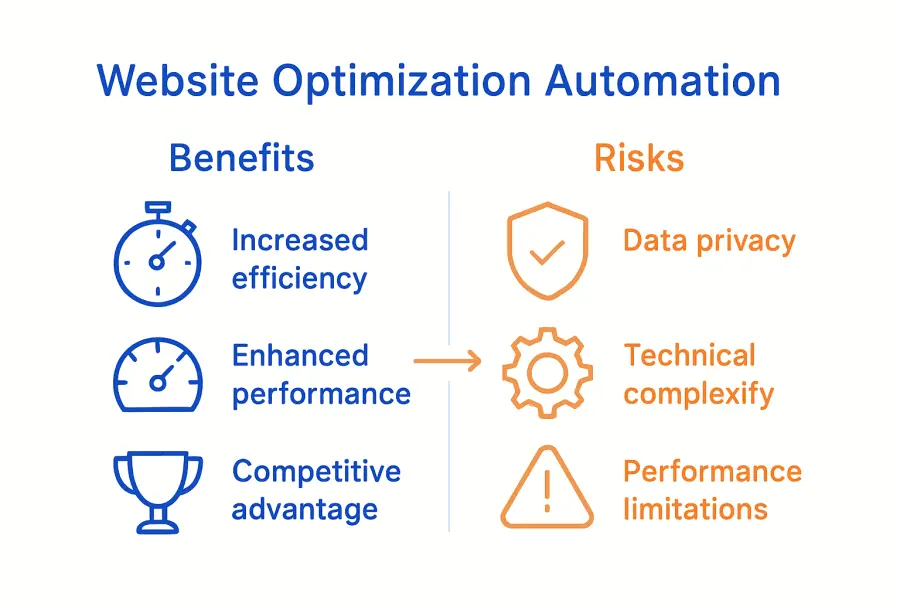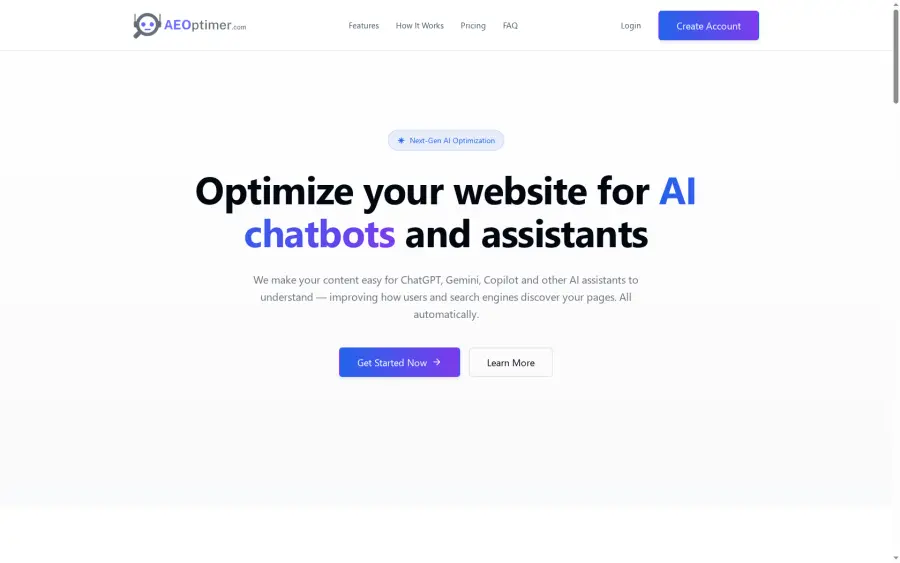Role of Automation in Website Optimization: Complete Guide

Most websites miss hidden growth opportunities because manual updates simply cannot keep up with fast-changing digital demands. As online competition intensifies, businesses need smarter solutions that work around the clock. Over 60 percent of top-performing sites now use automated systems to stay ahead, dynamically adjusting everything from content to user experience. This article explores how automation is transforming website optimization, why it matters for long-term success, and what tools make the biggest impact.
Table of Contents
- Defining Automation In Website Optimization
- Core Automated Processes And Technologies
- Benefits Of Automated Website Optimization
- Risks And Challenges Of Website Automation
- Best Practices For Maximizing Automation Impact
Key Takeaways
| Point | Details |
|---|---|
| Automation Enhances Optimization | Automation transforms website management by employing AI and machine learning for continuous performance monitoring and real-time content adaptation. |
| Benefits of Automation | Automated website optimization leads to improved performance, strategic efficiency, and a competitive edge through responsive and dynamic digital environments. |
| Risks Involved | Organizations must navigate data privacy vulnerabilities, technical complexity, and performance limitations in adopting automation technologies. |
| Best Practices | Effective automation requires strategic planning, team enablement, and continuous improvement to maximize impact and address potential challenges. |
Defining Automation in Website Optimization
Website optimization automation represents a sophisticated technological approach to systematically enhancing online presence without constant manual intervention. Automation in this context transforms traditional website management by leveraging artificial intelligence and machine learning technologies to streamline complex optimization processes.
According to Wikipedia, AI SEO refers to the application of artificial intelligence technologies designed to enhance and automate the process of optimizing websites and online content for search engines. This means websites can now dynamically adjust their structure, content, and performance metrics through intelligent systems that continuously analyze and improve digital performance.
Key characteristics of website optimization automation include:
- Continuous performance monitoring
- Real-time content adaptation
- Automatic technical SEO improvements
- Intelligent data-driven recommendations
- Scalable optimization strategies
Website Optimization for AI: Complete Expert Guide demonstrates how adaptive technologies can transform website interactions. As Wikipedia explains, an adaptive website adjusts its structure and content in response to measured user interactions, ultimately optimizing future engagement.
The primary goal of automation in website optimization is to create intelligent, responsive digital environments that evolve seamlessly with user needs and search engine requirements. By eliminating repetitive manual tasks, businesses can focus on strategic growth while maintaining peak online performance.
Core Automated Processes and Technologies
Website optimization automation harnesses a complex ecosystem of technological processes designed to enhance digital performance with minimal human intervention. These automated technologies work seamlessly to analyze, adapt, and optimize websites in real-time, transforming traditional web management approaches.
ArXiv highlights the importance of continuous practices in technological development, which directly translate to website optimization. Continuous integration, delivery, and deployment enable organizations to frequently and reliably release new features and improvements, creating a dynamic and responsive digital environment.
Core automated processes in website optimization include:
-
Content Analysis and Optimization
- Automatic keyword detection
- Semantic content enhancement
- Readability score optimization
-
Technical Performance Management
- Automated site speed diagnostics
- Real-time performance monitoring
- Instant error detection and reporting
-
User Experience Automation
- Personalized content recommendations
- Interactive element optimization
- Adaptive design adjustments
Website Optimization for AI: Complete Expert Guide emphasizes the critical role of continuous experimentation. As research from ArXiv indicates, continuous A/B testing has been an established industry practice for over a decade, allowing websites to systematically improve their performance through data-driven insights.
These automated technologies represent a paradigm shift in website management. By leveraging intelligent systems that can analyze, predict, and optimize in milliseconds, businesses can maintain cutting-edge digital platforms without constant manual oversight.
 The result is a more efficient, responsive, and competitive online presence that adapts instantaneously to changing user needs and technological landscapes.
The result is a more efficient, responsive, and competitive online presence that adapts instantaneously to changing user needs and technological landscapes.
Benefits of Automated Website Optimization
Website optimization automation transforms digital strategy by delivering unprecedented efficiency and strategic advantages for businesses navigating the complex online landscape. By implementing intelligent automated systems, organizations can dramatically enhance their digital performance while minimizing manual intervention and operational overhead.
MECS Press emphasizes that a well-designed website using advanced search engine optimization techniques can help businesses survive and thrive in increasingly competitive digital environments. Automated optimization provides a critical competitive edge by ensuring websites remain dynamically responsive to evolving user expectations and search engine algorithms.
Key benefits of automated website optimization include:
-
Performance Enhancement
- Continuous site speed improvements
- Automatic error detection and correction
- Real-time performance monitoring
-
Strategic Efficiency
- Reduced manual workload
- Consistent content optimization
- Data-driven decision making
-
Competitive Advantage
- Faster adaptation to market changes
- Enhanced user experience
- Improved search engine rankings
However, it’s crucial to recognize potential limitations. MDPI research highlights that novice users might encounter challenges with AI-driven web optimization tools, particularly in complex customization tasks. This underscores the importance of selecting sophisticated, user-friendly automation solutions that balance technological complexity with intuitive design.

Why AI Optimized Websites: Complete Guide 2024 reveals that automated optimization is not about replacing human creativity, but augmenting it. By handling repetitive technical tasks, these systems free up human professionals to focus on strategic content creation, innovative design, and nuanced user engagement strategies that truly differentiate a brand in the digital marketplace.
Risks and Challenges of Website Automation
Website automation, while powerful, introduces a complex landscape of technological and strategic challenges that organizations must carefully navigate. The promise of seamless optimization is often accompanied by potential risks that can undermine the very performance improvements these systems aim to achieve.
Dev.to highlights a critical concern: AI systems rely on substantial data for accurate functioning, which raises significant issues regarding user privacy and security. This data dependency means websites must implement robust safeguards to protect sensitive information while simultaneously leveraging automated optimization techniques.
Key risks and challenges in website automation include:
-
Data Privacy Vulnerabilities
- Potential unauthorized data collection
- Risk of personal information exposure
- Complex consent management requirements
-
Technical Complexity
- Potential system integration challenges
- Algorithmic bias and unpredictability
- Increased cybersecurity attack surfaces
-
Performance Limitations
- Reduced human oversight
- Potential misalignment with brand voice
- Unexpected optimization outcomes
ArXiv research comprehensively documents the multifaceted challenges of continuous experimentation, identifying cultural, organizational, business, technical, statistical, ethical, and domain-specific obstacles that can emerge during automation implementation.
Why AI Assistants Matter for Websites: Complete Guide suggests that successful automation requires a balanced approach. While technological solutions offer incredible potential, human judgment remains crucial in interpreting results, maintaining strategic alignment, and ensuring that automated systems truly serve the organization’s broader objectives.
Best Practices for Maximizing Automation Impact
Website automation represents a strategic investment that requires thoughtful implementation and ongoing management. Successful organizations understand that automation is not a set-it-and-forget-it solution, but a dynamic process demanding continuous refinement and strategic oversight.
ArXiv research identifies critical factors for introducing continuous practices, emphasizing the importance of team awareness, transparency, good design principles, and building a highly skilled and motivated team. These foundational elements are crucial for transforming automated systems from mere technological tools into strategic assets that drive meaningful business outcomes.
Key best practices for maximizing automation impact include:
-
Strategic Planning
- Define clear automation objectives
- Align automation with business goals
- Establish measurable performance metrics
-
Team Enablement
- Invest in continuous skills training
- Foster a culture of technological adaptability
- Encourage cross-functional collaboration
-
Continuous Improvement
- Regular performance audits
- Iterative system refinement
- Proactive risk management
ArXiv further recommends developing comprehensive infrastructure and experimentation process models that help organizations mitigate potential challenges while solving complex optimization problems.
Monthly Website Optimization Steps for AI Discoverability suggests that successful automation requires a holistic approach. By combining technological solutions with human insight, businesses can create adaptive systems that not only streamline operations but also maintain the nuanced strategic thinking essential for long-term digital success.
Unlock Seamless Website Optimization with Automation
The article highlights the challenges of keeping websites optimized for AI assistants and search engines through continuous manual effort and complex technical tasks. You want your site to stay visible and relevant, but manual optimization can be overwhelming and time-consuming. Key pain points include the need for continuous content updates, automatic technical SEO improvements, and real-time adaptation without requiring deep technical expertise. Automation is the future, but finding the right solution that balances technology with ease of use is critical.
At aeoptimer.com, we understand these challenges and offer a powerful SaaS platform designed to automate your website optimization effortlessly. Our system adds structured data and AI-friendly content enhancements without changing your site’s appearance. It continuously crawls and updates your pages monthly to keep you aligned with evolving search trends and AI requirements like those from ChatGPT and Gemini. This means you can focus on your business while we ensure your website remains highly discoverable and competitive in AI-driven search results.
Ready to eliminate manual workload and boost your AI discoverability today?

Experience the future of website optimization. Visit aeoptimer.com now to start your journey toward smarter, automated SEO that keeps you ahead. Learn how automated content updates and AI-focused enhancements can give your site the competitive edge it deserves. Don’t wait for your competitors to optimize first—take control and optimize continuously with us.
Frequently Asked Questions
What is website optimization automation?
Website optimization automation is a technological approach that enhances online presence systematically without constant manual intervention, using AI and machine learning to streamline optimization processes.
How does automation benefit website performance?
Automation improves website performance by providing continuous monitoring, automatic error detection, and real-time content adaptation, ensuring that websites remain responsive to user needs and search engine algorithms.
What are the key processes involved in automated website optimization?
Key processes include content analysis and optimization, technical performance management, and user experience automation, all aimed at enhancing the website’s digital performance with minimal human oversight.
What challenges might arise from implementing website automation?
Challenges include data privacy vulnerabilities, technical complexity, and potential misalignment with brand voice, making it crucial to integrate human oversight into automated processes.





